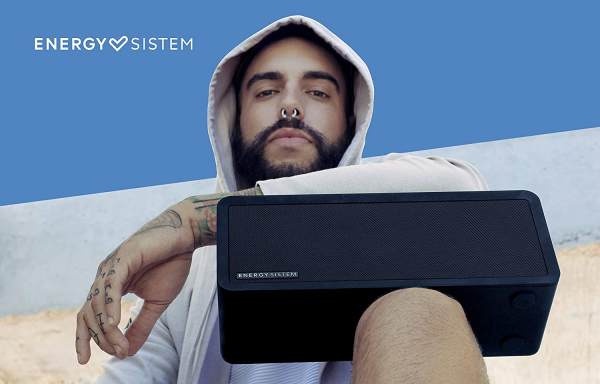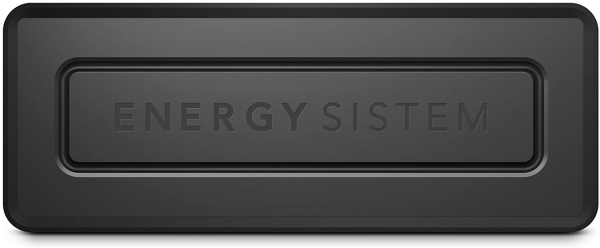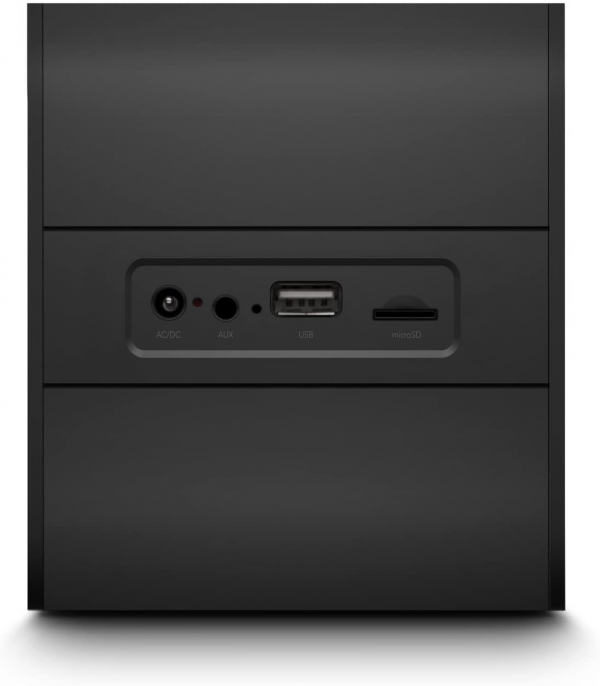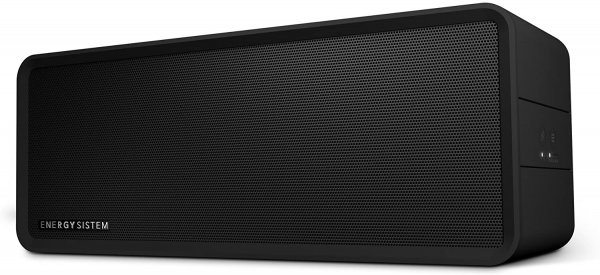Energy Sistem
Energy Sistem Music Box 9: a wireless speaker that struggles to convince
Aprox. 91€
See specificationsThe Music Box 9 is the first product from the Spanish brand Energy Sistem to enter our labs. It is the largest nomad wireless speaker in the manufacturer's very large catalog. This model relies on its size / power ratio, its launch price (€ 129) and its varied connectivity to conquer a market overloaded with references. Let's find out what it does in practice ...
Positive points
Balanced reproduction, from bass to midrange.
Good precision and good definition of bass.
A fairly varied connection.
Numerous light and sound indications.
Bad points
Significant imbalance on the second part of the sound spectrum.
Treble which can quickly become aggressive.
No multipoint connection via Bluetooth, a small latency perceptible in this connection mode.
No mark for FM and playback of stored files.
Our review
Ergonomics
The Music Box 9 does not make a fuss in terms of manufacturing. The shape of this portable nomadic enclosure is very classic: a rectangular shape with rounded edges, a rubberized rubber coating and a metal protective grid at the front. The upper side accommodates all the controls, the left and right sides house the connectors and the rear side is occupied by the passive radiator. Four non-slip silicone pads are present under the enclosure.
The manufacturing and finishes are rudimentary - we can easily see the assembly marks, and even the interior assembly behind the grid -, the coating retains fingerprints well, but we did not notice any defects during our test period, in any case nothing that compromises the proper functioning of the enclosure. It is important to remember that the manufacturer does not announce any certification of resistance, as well facing water as impact. A minimum of care should therefore be taken during use and transport. Nothing is provided to protect it.
Despite its "cheap" approach, this model does not overlook connection possibilities. The Music Box 9 offers an FM Tuner and Bluetooth 4.2 for wireless, with the possibility of pairing a second Music Box 9 for stereophonic or double monophonic broadcasting, a 3.5 mm mini-jack input for wired connection supplemented by a USB port and a microSD card slot.
These last two are only responsible for playing audio files (mp3 and wav placed in a FAT / FAT32 storage device of 128 GB maximum). Even if we appreciate the plurality of sources, the possibility of recharging a device or even connecting a PC or a smartphone as well as connecting two devices simultaneously via Bluetooth would have been well seen.
Energy Sistem's Music Box 9 is full of light and sound aids to guide the user. All the buttons are accompanied by luminous rings confirming each action and a small row of LEDs indicates the source being played at any time. Different audio aids simplify wireless pairing - whether with a reading device or with another speaker - and indicate that the min./max. volume is reached, for example.
The Music Box 9 offers all the important controls that we are entitled to expect on a speaker of this type: management of music playback, calls, listening volume, navigation between tracks, selection sources, switching the speaker on / off and triggering wireless pairing with a reading device or a second speaker.
However, not everything is rosy. Searching for stations and songs on USB stick / SD card is really not easy since there is no screen or application to find your way around. We are therefore constantly sailing blind. Despite the many indications, there is no way to know the battery level during use. The speaker notifies us only when the level becomes too low. Another point, less restrictive but noticeable: there is a small latency between the moment when a button is pressed and the moment when the action is taken into account in wireless connection. This offset is also found during playback, which is not necessarily the most comfortable to follow a video, especially during dialogues. When two speakers are paired together, the latency becomes much too high and it is then impossible to follow a video. Finally, to quibble, we would have appreciated that the volume control on the speaker is a little more precise.
The Music Box 9 of Energy Sistem offers, on paper, 20 hours of use after a full recharge with the listening volume set at 50%, 14 hours with the volume at 70% and 4 hours with the volume at full capacity. In practice, the duration of use indeed drops very quickly when you start to push the volume. At 50%, we could only reach 18 hours of listening, 3:30 pm at 60% and 11 hours with the volume at 70%. Even if it is far from being catastrophic, we still expected better on this point.
**
**
The built-in microphone does the job, but you still have to be near the speaker to be heard clearly (less than 1 m away, even indoors) for the caller. In our excerpt, you can hear our test phrase 1.3 m away, then 40 cm away from the speaker.

Audio
The sound experience offered by this Music Box 9 is uneven to say the least. The speaker correctly controls the reproduction of the first part of the spectrum, but it loses ground on the second.
Despite its volume, the Music Box 9 is not the most generous transportable speaker in the low frequencies. If they are not very deep and ample, the latter provide a correct foundation and we perceive a little impact on their part. In addition, they are well balanced, well defined and a minimum precise. Remember that the positioning of the speaker plays a significant role in how the bass will be flattered because the bass-reflex vent is at the rear. If it is placed near a wall or, worse, in a corner, the bass will be particularly boosted. There is not much to say up to about 2 kHz. The enclosure is always balanced.
Unfortunately, she finds it very difficult to restore the second part of the spectrum, from the high mids to the treble extremes. It is also the first thing that jumps out at the ears since this at least uneven response gives us the impression that the signal is as if split in two. The brightness of the treble is particularly accentuated, even at a contained listening volume. Precision is not really the order of the day in this region and the effects of parts are clearly put too much forward (reverberation, echo, etc.). What is more, the hollow in the high mids recedes the feeling of presence - even if we still perceive the voices very correctly. Depending on the songs, especially those rich in harmonics, this shiny aspect can very quickly transform into flickering accompanied by sibilance, which is tiring when listening. "Ssss" sounds tend to turn into "chhh" sounds. This can be heard, among other things, on cymbals or voices, for example. This phenomenon is more discreet when you go over pieces that are naturally very warm and less loaded with sources. Note also that the stereophonic width is correct, but it is strictly limited to the edges of the enclosure. Obviously, the problem no longer arises when two speakers are used, but we have clearly known better in terms of readability and stability of the phantom center. The Music Box 9 is directive, you have to think of placing it towards the listening point to get the best of it.
It may well offer good power, it is unfortunately not really usable since it must be below 65% of the maximum listening volume to preserve the aggressiveness from the treble. What is more, the duration of use is really dependent on the level of power required from the speaker. If you want to enjoy a correct autonomy, it is better not to push the volume too much.

Conclusion
Despite some interesting features, the nomadic Music Box 9 speaker is hard to convince. In question, not only a lack of control in sound reproduction, but also some small ergonomic failures. If you are looking for a powerful transportable speaker, it is better to look at the side of the JBL Xtreme (for backpacker use) or Addon T3 (for sedentary use), for example. In case your budget is more limited, it is better to look at the side of portable speakers.

Specifications

